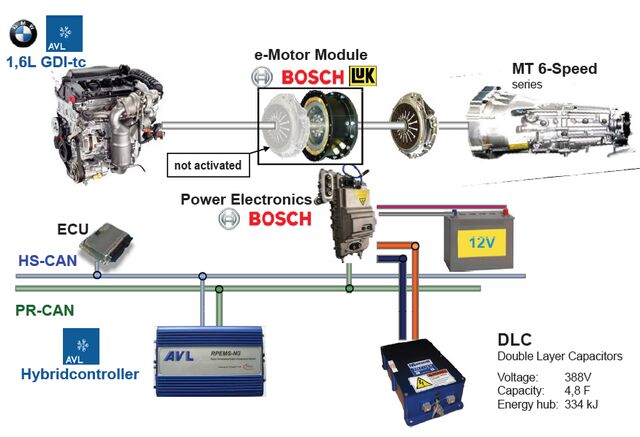Turbohybrid Beats The Battery. Sort Of.
The vocabulary used to classify hybrid drivetrains has been lagging considerably behind new developments, as Wikipedia’s article on the matter proves. The old parallel, serial, mild and plug-in hybrid categories do little to illuminate public understanding of the underlying technology, and much to confuse it. Enter the BYD Dual-Mode, VW “ Twindrive” and, now, the AVL “ Turbohybrid”. With cooperation from BMW, Bosch and LuK, AVL has developed a mild-ish hybrid drivetrain. The consortium claims it’s cheaper and more fun to drive than a “full hybrid” while offering nearly the same efficiency. Care to deep dive?
The system is built around a turbocharged, direct-injection 1.6-liter engine (tuned for a flat torque curve) coupled to a long-geared manual transmission and a clever electric drive strategy. Electric power replaces low-end torque lost to tall gearing. AVL also claims that turbo overboost maintains a steady charge. Even if you only have, say )slowly), a 15kW double layer capacitor module instead of a lithium-ion battery, you don’t loose [sic] no juice.
Still awake?
That’s how the boffins rolled during testing of their Stage One (v1.0?) system. Even without regenerative braking or a high-capacity battery, AVL claims that its BMW 320i mule was 24 percent more efficient (NEDC) than a stop-start equipped, naturally-aspirated 320i– at an estimated 150 percent of the price.
And though that doesn’t sound great, a certain unnamed 1.5 liter power-split hybrid (Prius) offered only 36 percent better efficiency than the NA 320i at (again, estimated) 300 percent of the price (to produce, of course). Those BMW badges are expensive.
Anyway, the kicker (claims AVL): the Turbohybrid 320i is more fun to drive than either a weedy NA four-banger Beemer or a Prius. And that I buy.
Check out their release for graphs of elasticity, tip-in, and other “fun to drive” proving stuff.
More by Edward Niedermeyer
Latest Car Reviews
Read moreLatest Product Reviews
Read moreRecent Comments
- AZFelix UCHOTD (Used Corporate Headquarters of the Day):Loaded 1977 model with all the options including tinted glass windows, People [s]Mugger[/s] Mover stop, and a rotating restaurant. A/C blows cold and it has an aftermarket Muzak stereo system. Current company ran okay when it was parked here. Minor dents and scrapes but no known major structural or accident damage. Used for street track racing in the 80s and 90s. Needs some cosmetic work and atrium plants need weeding & watering – I have the tools and fertilizer but haven’t gotten around to doing the work myself. Rare one of a kind design. No trades or low ball offers – I know what I got.
- El scotto UH, more parking and a building that was designed for CAT 5 cable at the new place?
- Ajla Maybe drag radials? 🤔
- FreedMike Apparently this car, which doesn't comply to U.S. regs, is in Nogales, Mexico. What could possibly go wrong with this transaction?
- El scotto Under NAFTA II or the USMCA basically the US and Canada do all the designing, planning, and high tech work and high skilled work. Mexico does all the medium-skilled work.Your favorite vehicle that has an Assembled in Mexico label may actually cross the border several times. High tech stuff is installed in the US, medium tech stuff gets done in Mexico, then the vehicle goes back across the border for more high tech stuff the back to Mexico for some nuts n bolts stuff.All of the vehicle manufacturers pass parts and vehicles between factories and countries. It's thought out, it's planned, it's coordinated and they all do it.Northern Mexico consists of a few big towns controlled by a few families. Those families already have deals with Texan and American companies that can truck their products back and forth over the border. The Chinese are the last to show up at the party. They're getting the worst land, the worst factories, and the worst employees. All the good stuff and people have been taken care of in the above paragraph.Lastly, the Chinese will have to make their parts in Mexico or the US or Canada. If not, they have to pay tariffs. High tariffs. It's all for one and one for all under the USMCA.Now evil El Scotto is thinking of the fusion of Chinese and Mexican cuisine and some darn good beer.

































Comments
Join the conversation
@ psarhjinian I recall the term lingered long after the button did nothing. The "turbo" word seemed to make it's way into everything else at the time too. It was a catch-all replacement for "super". Here another example. "I'd even bought a vacuum cleaner because it had the word 'turbo' on it!" Ah... the memories...
@ menno Hydraulic hybrids are interesting up'n'comers. One to watch for sure. The pros and cons as I understand it are; 1. Excellent regenerative recovery compared to electric. 2. Constant speed drive efficiency still significantly lower than direct drive via CVT from high pressure system heat losses. 3. Limited alternate power source only range. You can't store more than a few miles of hydrostatic pressure. 4. Combined system weight in smaller applications is higher than electric. Looking good for heavy vehicles (Hino have a hydro/hybrid test bed with running gear courtesy of the forklift division probably). 5. Packaging/drive component arrangement flexibility. Obviously all those things are being worked on - somewhere. I'm not aware of any of the major manufacturers pursuing it however.